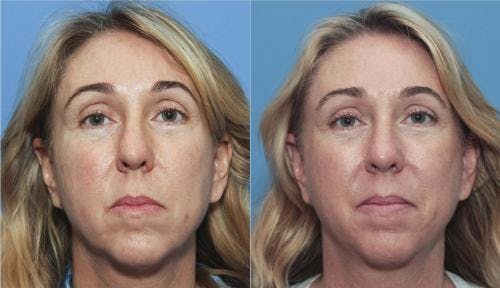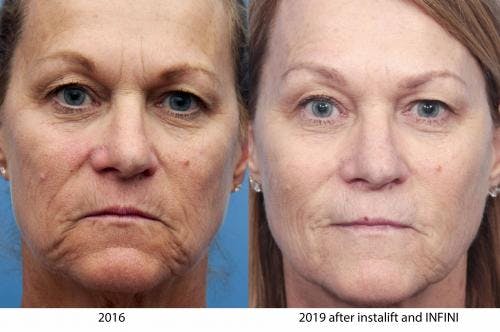Sagging skin is one of the major contributors to an aged and tired appearance. Silhouette InstaLift™ is a minimally invasive, in-office procedure to re-contour your mid-face by lifting the deeper layers of your skin for a more youthful appearance.
Is Silhouette InstaLift™ FDA cleared?
The product earned FDA-clearance in April 2015.
Who is a good candidate to have a Silhouette InstaLift™ procedure?
Silhouette InstaLift is the ideal minimally-invasive solution for many men and women who are interested in refreshing their appearance without major surgery, injections, or lasers. It offers a new and unique technology to lift sagging facial skin. Suitable candidates have good skin quality, with moderate sagging of the skin in the mid-face. Skin should not be too thick/heavy or too thin.
What are Silhouette InstaLift™ sutures made of?
Silhouette InstaLift™ sutures are made from glycolide / L-lactide (PLGA), a polymer that is frequently used in medical devices and is well tolerated by the body. The fully resorbable sutures have bi-directional cones; the sutures lift and add volume while the bi-directional cones hold the suture and cheek sub-dermis in an elevated position.
What can Silhouette InstaLift™ do to improve my appearance?
Sagging facial skin is one of the major contributors to an aged and tired appearance. Silhouette InstaLift™ is a minimally-invasive procedure that redefines the contours of your mid-face by lifting the deeper layers of your skin for a more youthful look.
What areas of the face does Silhouette InstaLift™ treat?
The procedure lifts and restores contours to the mid-face and cheek area.
How is the Silhouette InstaLift procedure performed?
During the in-office procedure, a specially-trained physician will begin by marking the areas of desired lift on the patient. He will then gently insert a needle to a depth of 5mm and guide it through the subcutaneous tissue of the mid-face and extract at each bi-directional exit point. The sutures have bi-directional absorbable cones that hold them in place. The treatment is generally well tolerated by patients and takes approximately 45 minutes.
Is general anesthesia required?
No. Your physician will only use a local anesthetic to numb the area before inserting the sutures.
How is Silhouette InstaLift™ different from Thread Lifts?
Silhouette InstaLift™ is an entirely new technology and procedure. Rather than just repositioning the skin, Silhouette InstaLift™ now focuses on the underlying layers of the skin, because that is what really causes sagging. Another important advance is that the sutures are not permanent; they are absorbed by the body over time. As they are absorbed, they stimulate collagen renewal, which helps achieve a younger, natural look.
How much does Silhouette InstaLift™ cost?
The procedure fee varies according to each patient’s needs and the number of sutures required.
Where can I have Silhouette InstaLift™ performed?
Silhouette InstaLift™ is only performed by qualified physicians who have undergone special, comprehensive training and are familiar with the techniques required.
Who is a non-ideal patient?
The Silhouette InstaLift™ device should not be used in patients with any known allergy or foreign body sensitivities to plastic biomaterial or in situations where internal fixation is otherwise contraindicated, (e.g. infection). The device should also not be used in patients appearing to have very thin soft tissue of the face in which the implant may be palpable or in patients with excessive heavy skin.
What are the side effects that might happen with this procedure?
After placement, patients may experience a minimal acute inflammatory tissue reaction. Symptoms may include minor pain, swelling and bruising. Material sensitivity / allergic reactions should be reported to Silhouette Lift Inc. Implantation of foreign materials in tissue can result in histological reactions. Other potential side effects include sensory nerve injury, asymmetry, or banding.









